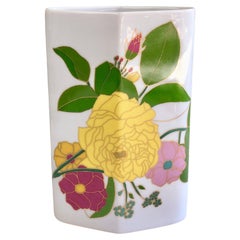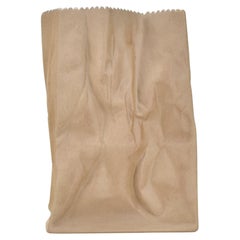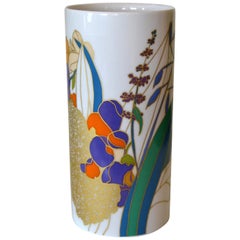Wolfgang Bauer Furniture
2
to
1
1
2
2
2
2
2
2
2
2
1
1
1
2
2
1
5,291
4,012
2,454
2,235
Creator: Wolfgang Bauer
Original Rosenthal Porcelain Flower Plate Studio-Linie Germany by Wolfgang Bauer
By Wolfgang Bauer, Rosenthal
Located in Miami, FL
Striking original Rosenthal porcelain hand painted flower plate designed by Wolfgang Bauer and made in Germany for Studio-Linie.
This 100 Years Anniversary Collectable Wall Plate...
Category
Late 20th Century German Mid-Century Modern Wolfgang Bauer Furniture
Materials
Gold Leaf
Abstract Floral Vase Rosenthal Studio-Line, by Wolfgang Bauer 1970s, Germany
By Rosenthal, Wolfgang Bauer
Located in Andernach, DE
Mid to late 20th century vase by Rosenthal, Studio-Line. Wonderful colourful abstract shape and decoration: flowers in
bright pastel colours with golden outlines on a crisp white ba...
Category
Late 20th Century German Mid-Century Modern Wolfgang Bauer Furniture
Materials
Porcelain
Related Items
14 Artists Plates Collection Limited Edition by Rosenthal, Max Bill, Dali, Pucci
By Jean Cocteau, Max Bill, Rosenthal, Bjorn Wiinblad, (after) Salvador Dali
Located in Andernach, DE
Extraordinary collection of 14 Artists-Plates by Rosenthal, Germany.
Ranging from 1971 to the mid 1980s, this series from their artists ''Studio-Line'' features designs from artist r...
Category
Mid-20th Century German Mid-Century Modern Wolfgang Bauer Furniture
Materials
Porcelain
Free Shipping
H 1.26 in Dm 10.24 in
Tapio Wirkkala Paper Bag Vase Brown Porcelain by Rosenthal Studio Line Germany
By Rosenthal, Tapio Wirkkala
Located in Bad Säckingen, DE
This early brown paper bag shaped vase of the "Do not litter" collection designed by Tapio Wirkkala for Rosenthal studio-line is an iconic piece of mid-century modern design. It was ...
Category
Mid-20th Century German Mid-Century Modern Wolfgang Bauer Furniture
Materials
Porcelain
H 7.64 in W 4.93 in D 3.27 in
Rosenthal Studio Line Porcelain Plate by Björn Wiinblad 'Limited Edition'
By Bjorn Wiinblad, Rosenthal
Located in Waddinxveen, ZH
Stunning wall plaque by Bjorn
Wiinblad for Rosenthal. The plaque was produced in 1975 in an edition of 5000, and this one is number 1328.
The text on the plate is German ‘auch die...
Category
1970s German Mid-Century Modern Vintage Wolfgang Bauer Furniture
Materials
Porcelain
Pollo Vase by Tapio Wirkkala for Rosenthal Studio Line
By Rosenthal, Tapio Wirkkala
Located in Philadelphia, PA
Beautiful Porcelin Pollo Vase by Tapio Wirkkala for Rosenthal Studio Line.
Category
1970s German Scandinavian Modern Vintage Wolfgang Bauer Furniture
Materials
Porcelain
Artist Plate No. 2 by Jean Cocteau for Rosenthal, Mid-Century, 1970s Germany
By Jean Cocteau, Rosenthal
Located in Andernach, DE
Art print wall plate by Jean Cocteau:
''Es gibt immer ein Gegenüber: ohne teufel hätte gott nie die breite Masse angesprochen'' (''There is always a counterpart: without the devil, G...
Category
Mid-20th Century German Mid-Century Modern Wolfgang Bauer Furniture
Materials
Porcelain
Set of 3 Bjørn Wiinblad for Rosenthal, Christmas Glass Plates 1976, 1977 & 1980
By Rosenthal, Bjørn Wiinblad
Located in Andernach, DE
Bjorn Wiinblad, Danish artist, has created this beautiful series for German art glass & porcelain makers Rosenthal for their Studio-Line art edition.
The Christmas decoration has bee...
Category
Late 20th Century German Mid-Century Modern Wolfgang Bauer Furniture
Materials
Crystal
H 0.6 in W 11.42 in D 11.42 in
Vintage Geometric Vase Rosenthal Studio Line Porcelain, Germany
By Rosenthal
Located in Bastogne, BE
Vintage Geometric Vase Rosenthal Studio Line Porcelain, Germany Art Deco Vase With Gold, Blue and Rouge Paint.
The hand paint is in an art deco style and is abstract in its' patter...
Category
1970s German Art Deco Vintage Wolfgang Bauer Furniture
Materials
Porcelain
Rosenthal Porcelain Flower Cylinder Vase by Wolf Bauer, Germany
By Rosenthal
Located in Barntrup, DE
A hand-painted Rosenthal porcelain vase designed by Wolf Bauer, the Studio-Linie line, Germany, 1970s-1980s.
The white porcelain vase is in a cylindrical form and is adorned with br...
Category
1970s German Mid-Century Modern Vintage Wolfgang Bauer Furniture
Materials
Porcelain
Designer White Matte Porcelain Vase by Rosenthal Studio-Line
By Rosenthal
Located in New York, NY
A beautiful German designer oval white matte porcelain ceramic pottery vase by Rosenthal 'Studio-Line', Germany. With marker's mark's and designer signature on bottom as show in imag...
Category
Late 20th Century German Minimalist Wolfgang Bauer Furniture
Materials
Porcelain, Pottery, Ceramic
Op-Art Studio line Bisque porcelain vase, by Martin Freyer Studio Line Rosenthal
By Rosenthal, Martin Freyer
Located in Skarpnäck, SE
A fantastic Bisque porcelain Op-Art vase from Studio line Rosenthal made by the talented Martin Freyer, Germany. A rather large black ceramic vase with incredible design. The vase is...
Category
1960s German Mid-Century Modern Vintage Wolfgang Bauer Furniture
Materials
Ceramic, Porcelain
Free Shipping
H 6.66 in W 2.95 in D 2.55 in
Glass Vase by Martin Freyer for Rosenthal Studio Line
By Rosenthal, Martin Freyer
Located in Niederdorfelden, Hessen
Glass vase by Martin Freyer for Rosenthal Studio Line, Germany 1960s-70s.
Category
1960s German Mid-Century Modern Vintage Wolfgang Bauer Furniture
Materials
Art Glass
1970s VASARELY "Live and let live love and let love" Rosenthal Framed Plate
By Rosenthal, Victor Vasarely
Located in North Hollywood, CA
1970s VICTOR VASARELY "Live and let live love and let love".
Rosenthal collectible framed German plate.
Victor Vasarely Rosenthal Studio Line Limited Edition Porcelain Plate.
By Vasarely born 1936.
"Leben und Leben lassen, Lieben und Lieben lassen"
"Live and let live - love and let love".
Limited edition, signed and numbered.
Plate is in good condition, size is 12".
Frame is not in good condition, white became yellowish shows wear.
Victor Vasarely, born as Győző Vásárhelyi on April 9, 1906, in Pécs, Hungary, was a Hungarian-French artist widely regarded as the "father of Op Art" (Optical Art). He is known for his pioneering work in geometric abstraction and the use of optical illusions to create visually captivating and dynamic artworks.
Vasarely's early career involved studying medicine in Budapest, but he later decided to pursue his passion for art and enrolled in the Műhely (Workshop) academy in Hungary. He initially experimented with various styles, including Impressionism and Post-Impressionism, but his interest in geometric abstraction grew stronger over time.
In the 1930s, Vasarely moved to Paris, where he continued to explore geometric patterns, lines, and shapes in his art. He believed that art should not merely imitate nature but should create its own language of forms and colors to engage the viewer's perception actively. This philosophy led to the development of Op Art, a movement that emerged in the 1960s and focused on creating optical illusions and visual effects through precise geometric patterns and colors.
Vasarely's artworks often featured meticulously arranged geometric shapes, giving the impression of movement and three-dimensionality. He employed various optical tricks, such as the juxtaposition of contrasting colors and the use of repetition, to create an illusion of depth and visual dynamism. His artworks can evoke a sense of visual vibration and often challenge the viewer's perception.
Throughout his career, Vasarely's influence extended beyond the art world. He believed in the democratization of art and wanted to make art accessible to a wider audience. He embraced mass production techniques, creating what he called "multiple originals" or "serigraphs" (a form of screen printing). These serigraphs allowed him to produce multiple copies of his artworks at affordable prices, making them more accessible to art enthusiasts.
Vasarely's artistic legacy continues to be celebrated around the world. His work has been exhibited in numerous galleries and museums, and he remains an influential figure in the fields of Op Art and abstract geometric art. He passed away on March 15, 1997, in Paris, leaving behind a vast body of work that continues to captivate audiences and inspire artists to this day.
About Rosenthal:
German porcelain manufactory Rosenthal was originally founded as a ceramics-painting studio by Philipp Rosenthal Sr. (1855-1937) in 1879 at Schloss Erkersreuth in Bavaria, near the Czech border. Its first highly popular product was an ashtray inscribed with the words “Resting place for lit cigars.” In 1890, the company moved to the neighboring hamlet of Selb and, a year later, began to manufacture its own porcelain, since white porcelain was, at that time, in short supply. Rosenthal’s first complete table service was called Empire; it was exhibited along with other lines at Paris’s Exposition Universelle in 1900.
With the dawn of the 20th century, Rosenthal began producing porcelain tableware and services formed and decorated in the latest styles, like the Jugendstil Botticelli (1903), the Art Nouveau Darmstadt (1905), and the all-white Maria (1916) lines. Successes with this au courant approach led the company to launch an art pottery division in 1910, dedicated to luxury tableware, vases, and other decorative objects. By the 1930s, figurines were another important Rosenthal product, most notably the Disney-licensed Mickey Mouse pieces introduced in 1931.
In 1934, Philipp Rosenthal was forced to leave his company and country when his Jewish ancestry came under persecution by the Nazi regime. Despite the loss of its founder, the Rosenthal company remained the premier supplier of high-quality porcelain tableware to the Third Reich. After the war, in 1950, Philip Rosenthal Jr. (1916-2001) joined his father's company as an advertising manager. By 1958, he had become its CEO, continuing his father’s vision to produce high-quality porcelain in line with progressive tastes. Through the rest of the 20th century, Rosenthal was the most commercially successful porcelain producer in Germany.
In the postwar era, Rosenthal’s most famous tableware lines have included 2000 by Raymond Loewy and Richard Latham (1954), Magic Flute by Bjørn Wiinblad (1959), Suomi by Timo Sarpaneva (1976), and Moon by Jasper Morrison (1997). The company has enjoyed many popular and critically acclaimed collaborations with designers and brands, like Salvador Dalì, Tapio Wirkkala, Walter Gropius, Andy Warhol, Ron Arad, Enzo Mari, Konstantin Grcic, and Versace.
Rosenthal's product lines have encompassed more than ceramics over the years. In 1972, the company began producing furniture, under the subsidiary Rosenthal Einrichtung, in Espelkamp, Germany. Standouts from this arm of Rosenthal include Gunter Ferdinand Ris and Herbert Selldorf’s futuristic Sunball Lounge Chair (1969), Verner Panton’s Relaxer Rocking Chair (1974), Burchard Vogtherr's Vario Pillo...
Category
Late 20th Century German Post-Modern Wolfgang Bauer Furniture
Materials
Porcelain
H 15.5 in W 15.5 in D 2 in
Previously Available Items
Original Rosenthal Porcelain & Gold Vase Studio-Linie Germany by Wolfgang Bauer
By Wolfgang Bauer, Rosenthal
Located in Miami, FL
Striking original Rosenthal porcelain hand painted gold flower vase designed by Wolfgang Bauer and made in Germany for Studio-Linie.
The vase feature...
Category
1950s German Mid-Century Modern Vintage Wolfgang Bauer Furniture
Materials
Gold Leaf
H 8.5 in W 5.5 in D 2.75 in
Original Rosenthal Porcelain Flower Vase Studio-Linie Germany by Wolfgang Bauer
By Wolfgang Bauer, Rosenthal
Located in Miami, FL
Striking original Rosenthal porcelain hand painted flower vase designed by Wolfgang Bauer and made in Germany for Studio-Linie.
The vase features...
Category
1950s German Mid-Century Modern Vintage Wolfgang Bauer Furniture
Materials
Gold Leaf
Floral Porcelain Vase by Rosenthal
By Wolfgang Bauer, Rosenthal
Located in New York, NY
An exceptional floral-patterned porcelain pillow vase from the Summer collection designed by Wolfgang Bauer for Rosenthal Studio Linie. Germany, circa 1960. Signed. Features multi...
Category
1960s German Mid-Century Modern Vintage Wolfgang Bauer Furniture
Materials
Porcelain
Wolfgang Bauer furniture for sale on 1stDibs.
Wolfgang Bauer furniture are available for sale on 1stDibs. These distinctive items are frequently made of porcelain and are designed with extraordinary care. There are many options to choose from in our collection of Wolfgang Bauer furniture, although brown editions of this piece are particularly popular. Many of the original furniture by Wolfgang Bauer were created in the mid-century modern style in germany during the 20th century. If you’re looking for additional options, many customers also consider furniture by Uta Feyl, Hans Theo Baumann, and Wallendorf. Prices for Wolfgang Bauer furniture can differ depending upon size, time period and other attributes — on 1stDibs, these items begin at $211 and can go as high as $550, while a piece like these, on average, fetch $381.





